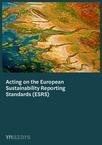First set of ESRS: what companies can learn from the EC draft delegated act
Required by the Corporate Sustainability Reporting Directive (CSRD), ESRS prescribe both the content and format of sustainability-related information intended to meet users’ needs for high-quality, comparable and relevant information.
While the first companies within the CSRD scope will have to apply the ESRS from 1 January 2024, the European Commission is just about to adopt Set 1, i.e. 12 standards applicable by all companies regardless of the sector they operate in.
What are the main challenges for companies?
ESRS represent a major shift, creating new demanding transparency obligations on companies as regards their commitment to sustainability, especially as the sustainability information will have to be audited (with limited assurance over compliance with ESRS required at inception, and a possible move to reasonable assurance).
As a first step, companies should first assess whether they are within the scope of the CSRD and when they will have to publish sustainability information under ESRS for the first time.
Challenges in implementing ESRS will depend on whether the company was already subject to the Non-Financial Reporting
Directive (NFRD) requirements and in which Member State it is established, as the NFRD left significant flexibility to Member States to transpose into national law.
In all cases, first-time application of Set 1 will necessitate revisiting the materiality assessment and considering the entire value chain. Then a thorough analysis of the disclosure requirements (or DRs) listed in ESRS will have to be performed in order to identify which material information has to be disclosed to cover material impacts, risks and opportunities identified by the company in relation to its sustainability matters.
What are the key features of ESRS?
Under ESRS, sustainability-related information takes a double-materiality approach to the full spectrum of environmental,
social and governance (ESG) topics, whereby companies will have to report both on the impacts of their activities on people
and the environment, and on how various sustainability matters affect them financially.
While this first draft of ESRS covers all information that is likely to be material regardless of the sector(s) companies operate in, sector-specific standards will subsequently complement these sector-agnostic standards. This represents another major step as most sustainability-related topics are relevant only when taking a sectoral approach. In addition, entity-specific information will also have to be provided, where necessary (i.e. in order to cover all the material impacts, risks and opportunities identified).
The reporting structure of ESRS is aligned with the Recommendations of the Task Force on Climate-related Financial
Disclosures (TCFD) and therefore covers governance, strategy, management of impacts, risks and opportunities, as well as metrics and targets.
In practice, Set 1 includes 12 draft sector-agnostic standards, two cross-cutting standards and ten topical standards, including five on environmental matters, four covering social matters and one on governance.
The content of these standards is consistent with other EU legislation such as the Sustainable Finance Disclosure Regulation (SFDR) regarding the “principal adverse impacts” indicators, or the information required by regulatory technical standards prepared by the European Banking Authority (EBA) regarding Pillar III sector-agnostic disclosures.
Sustainability information will have to be presented in a clearly identifiable dedicated section of the management report. As per the CSRD, the management report will have to be both human and machine-readable, using the European Single Electronic Format (ESEF) to tag the sustainability information.
What are the main changes to EFRAG draft standards published in November 2022?
The main changes made by the EC on its draft delegated act release early June are:
- The expansion of the scope of the standards and of the sustainability-related information subject to materiality assessment, with, from now on, only ESRS 2 (general disclosures) to be applied mandatorily (except for its Appendix B which gathers information required by other EU legislation and disseminated in Set 1);
- The reinforcement of the transitional provisions listed in ESRS 1 (general requirements) with, in particular, a threshold for companies or groups not exceeding 750 employees now being introduced in the ESRS (notably, possibility for the latter to omit (i) all the DRs listed in ESRS S1 on own workforce for the first year and (ii) all the DRs listed in ESRS E4 on biodiversity and ESRS S2 to S4 the first two years);
- The new voluntary nature of certain disclosures (mainly on ESRS E4 and ESRS S1);
- The addition of targeted modifications, mainly to ensure proportionality of DRs. In concrete terms, these reliefs aim at introducing “safeguard measures” but also more flexibility, e.g. in relation to the materiality assessment process for environmental topics other than climate change;
- The greater coherence with the European legal framework;
- The enhanced interoperability with other global standard-setting initiatives;
- Editorial and presentational changes to improve the clarity and ease of use of the standards.
Next steps
The EC will adopt ESRS Set 1 by end of August 2023 at the latest by way of delegated act (meaning no transposition into national law is needed), which will then be followed by a scrutiny period by the European Parliament and Council. Following that, the ESRS will normally enter into force from January 2024 and will be immediately applicable at that date by large companies that are public interest entities with more than 500 employees (currently in the scope of the NFRD).
As we look ahead to the future, ESRS are set to provide a robust basis for reporting sustainability information. In the
meantime, companies should act now in order to comply with the new requirements and think about how to make this additional insight a strategic driver for their sustainability and business performance.
Download our ESRS guide below for more in-depth information on this new sustainability reporting framework and its impacts for companies.










